| |
|
St Mary,
Burston Your first thought on seeing it might be
that perhaps this is not one of Norfolk's more exciting
or interesting churches. A round tower fell in the 18th
century, and the parish could afford to do no more than
patch up the remains. After decades of neglect, the nave
and chancel were refashioned in an uncharacteristically
utilitarian manner by the Victorians, leaving a rather
barn-like structure. The nave walls, with their massive
Perpendicular-style windows and buttressing, look very
curious under the shallow tiled roof, but the scattering
of red brick at the west end gives it character, and the
whole piece is not unattractive in the tree-shrouded
graveyard. Internally, the church was converted for
community use in the 1990s, giving the nave the character
of a village hall. There was a further major
refurbishment and repair from 2013, thanks to a grant
from the Heritage Lottery Fund.
However, despite the battering, repatching and
refurbishing of the last couple of centuries, Burston
church is full of interest. It is open every day, and you
step in through the gloom of the rather austere Victorian
south porch into a church full of light. A light wooden
floor replaced the Victorian tiles, and, although none of
the nave furnishings were retained, the font is a decent
14th Century affair with characterful figures around the
stem. Above it on the west wall is one of Norfolk's best
James I royal arms, still in its original frame. The
chancel retains something of its 19th Century integrity,
some of the stencilling exposed from behind the limewash
which had concealed it in the 1960s when it had
deteriorated to such an extent that it had become
unsightly to eyes that in those days did not approve of
Victorianisation of this kind. The glass in the east
window is a good example of the more conservative strand
in 1930s stained glass, and it would be interesting to
know who the workshop was.
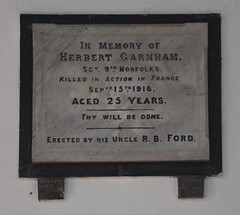 |
|
There
are memorials to two local boys killed in World
War One in the nave, and one of these is of
particular interest. It remembers Herbert
Garnham, killed on the Somme in September 1916.
He was 25 years old. Intriguingly, the
inscription records that the memorial was erected
by his uncle. This was because Herbert's
father had refused to allow a memorial to his son
in the parish church. The Garnhams were
participants in the Burston School Strike, a
violent dispute between the rector of this church
and the working people of the village. When
Herbert Garnham's father learned of the memorial
being placed in the church, he attacked it with a
sledgehammer, smashing it to the floor. For this,
he received a month in prison, and the memorial
was repaired and restored to the wall, although
you can still see the cracks in it today. So, what
was this disagreement that tore apart this small
rural community in the early decades of the 20th
Century? To answer that question you should look
immediately to the west of the churchyard, for
here on a patch of grass sits the world famous
Burston Strike School, a memory of what is
sometimes referred to as the longest strike in
British history.
|
In 1913,
Kitty and Tom Higdon, headmistress and senior teacher
respectively of the Burston Church of England village
school, came into dispute with the school managers after
Tom Higdon had been elected to the parish council. The
Higdons were Christian Socialists, and were widely
perceived as troublemakers. They refused to let the
children be taken out of school to help with the harvest,
or to do back-breaking, poorly-paid work like
stone-picking. Such employment was illegal, of course,
but it was the universal practice in rural areas at the
start of the 20th century.
The Higdons' nemesis was the Reverend Charles Tucker
Eland, Rector of St Mary. He was a clergyman of the old
type, an unchallenged authority figure in this parish
without a resident squire. Not surprisingly, he held
Victorian views of the relationships between the classes,
as did the majority of the tenant farmers. The 1870
Education Act had decreed universal education, but the
role of education was so often interpreted as preparing
the children for their place in the social order. Under
such circumstances, learning to read and write was
acceptable, but learning to think was positively to be
discouraged. It was expected that the boys of the parish
would become poorly-paid farm workers, and the girls
would go into service.
Tom Higdon was a popular figure with the local
farmworkers, and he championed their fight for higher
wages and better conditions. Universal suffrage for men
allowed him to top the poll in the Parish Council
elections, and the Reverend Eland came bottom, losing his
seat. But, crucially, he still led and controlled the
School Board. Within days, the School Board found an
excuse to sack the Higdons from their roles as
headmistress and senior teacher.
Twenty years earlier, that would probably have been the
end of the story. Twenty years later, it perhaps wouldn't
have happened at all. But this was a crucial moment in
European history. Far off, in Sarajevo, a single shot
fired at the Archduke Franz Ferdinand set in chain a
sequence of events that would lead to the Great War,
which would change rural East Anglia forever. It was also
to have an unforeseen effect on what happened next.
The Higdons set up an open air school on the village
green. Magnificently, the great majority of the poorer
families of the parish took their children out of the
village school and sent them to learn from the Higdons.
The establishment reacted. The Rector, shamefully,
expelled the striking families who held allotments on his
land, and he had their crops destroyed. Other families
were given notice to quit from their tied cottages.
However, these evictions were not carried through,
because the Great War had led to a serious shortage of
labour, and the tenant farmers simply could not afford to
lose their workers. The principles of the farmers were
not as strong as those of the farmworkers, or perhaps
they were merely pragmatic. In the event, the Strike
School survived and prospered, moving into a carpenter's
workshop that first winter, and then into a fully
equipped, brand new school funded by collections made by
Trade Union and Socialist organisations around the world.
The church school also continued, and by the 1920s the
two schools had settled down into an uneasy but workable
rivalry. The old order was falling away, the Reverend
Eland retired, and his replacement, Francis Smith,
supported both schools equally, giving religious
instruction in both. The Strike School lasted until 1939,
by which time the Higdons were both in their seventies.
After Tom died, Kitty gave up the school, and it closed.
The strike had lasted 25 years.
Today, the Strike School is a museum, but the village
green is still the focus for a national Trade Union rally
on the first Saturday of each September. The village
school continues to survive in the same buildings from
which the Higdons walked away a century ago. For many,
the main reason for visiting Burston today is the Higdons
and the story of Britain's longest strike. The Higdons
are buried side by side in the churchyard in simple
graves to the south-west of the church, by the churchyard
wall and only a few yards from the Strike School that
they set up.
Simon Knott, August 2018
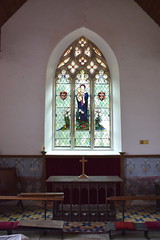  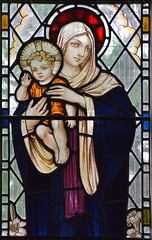 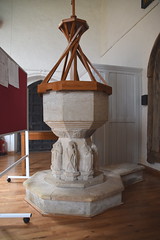
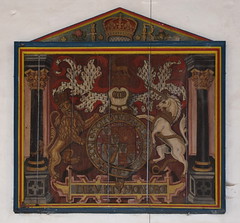 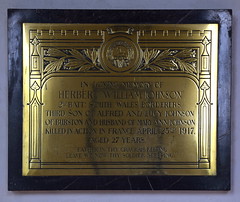 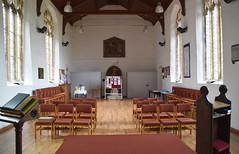
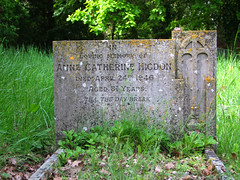 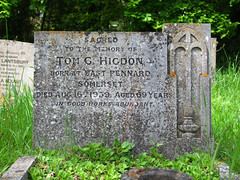
|
|
|
